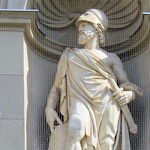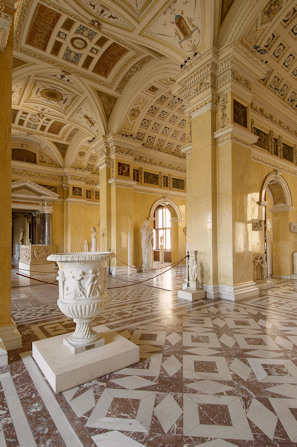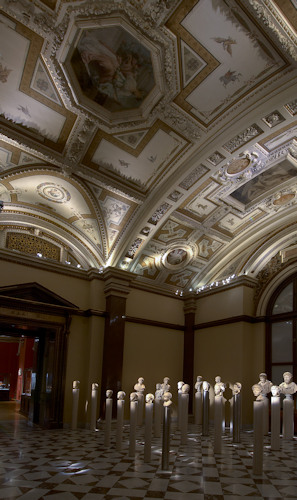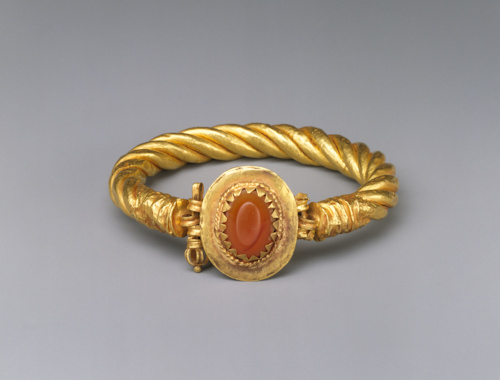
When you enter Gallery 10 in the Kunsthistorisches Museum (KHM), a change of flooring and presentation tells you that Ancient Egypt just gave way to the delights of Ancient Greece and Rome.
- Full of Greek and Roman art, jewellery, pottery and other artifacts
- Cameos and gemstones a particular highlight
- Beautifully atmospheric gallery layout
- Book your KHM museum tickets* online
- See also:
Ancient Greece and Rome

(Collection of Greek and Roman Antiquities; press photo © KHM-Museumsverband)
The transition to the classics in the Kunsthistorisches Museum comes across through both the style of the surrounds and the items themselves. For example, the first Greek statues you meet already represent a leap forward in artistic quality.
The curators clearly put a lot of thought into how items are displayed in this collection (see the highlights below). However, you might need your guidebook or an audio guide to really appreciate what you’re seeing.
So what raised my eyebrows in this collection?
The Highlights
- Gallery 11 features a huge original mosaic in the floor, taken from a 4th century villa near Salzburg
The mosaic tells one of the versions of the story of Ariadne and Theseus (he of Minotaur-slaying fame).
- Gallery 13 has a delightful display of busts, each on its own high column
As you walk toward this gallery, a glance at the entrance portal reveals a majestic Emperor Vespasian seemingly waiting to welcome you. His head is from 70AD, his torso from sometime in the first century.
The framing of the emperor from afar offers a perfect example of how the curators created something special through the design of the entire Greek and Roman wing.
The temple to Vespasian (and Titus) in Rome actually served as a model for the (fake) Roman ruins in the grounds of Schönbrunn Palace.
The bust gallery possesses an eerie quality enhanced by the subtle and varied lighting and shadows cast on the marbled floor.
Look also for the mummy portraits, which they placed on mummies in Rome-influenced Egypt in the second century AD.
- Gallery 14 features Greek vases and other ceramics. The kind of thing you’ll be familiar with from souvenir shops in Athens and Kos, except these are the real things
The “Kabinetts” leading off the rooms each focus on a special topic, such as Cypriot ceramics from the bronze and iron ages or Etruscan art. You’ll find more vases here than you can shake a souvlaki at.
- Gallery 15 is another atmospheric display, this time featuring bronze statues of the gods and other figures of mythology
The dark settings with pools of light for each piece make a dramatic impression.
Roman tableware, jewellery, decorated oil lamps and fibulae (brooches for fastening clothing) fill the rest of the room.

(The use of light and dark creates a stark impression; press photo © KHM-Museumsverband)
- Gallery 16 is probably my favourite with its miniature reliefs (cameos) and engraved gems from Rome.
These items found use as signet rings, pendants, and other adornments.
Again, the room is lit darkly, with wall cabinets and spotlights.
At a distance, the gem cabinets glitter like a collection of brightly-coloured beetles. As you walk past, watch how certain gems catch the light: particularly the orange carnelians.
The room also features the Gemma Augustea, a large cut onyx stone from ca. 9-12 AD with a 17th-century gold setting. It honours the Emperor Augustus and features various deities and personifications.
Like many precious works in the Kunsthistorisches Museum, the item came into Habsburg ownership through the acquisitional efforts of Rudolf II (1552-1612). This is the same emperor who commissioned the remarkable crown of the Austrian Empire, for example.
- Gallery 17 also profits from the creativity of the museum staff. Spot-lit cabinets house a wide range of Roman and early Germanic jewellery and other items of bronze, silver and gold.

(Example of a Roman Gold bracelet with a carnelian stone, 3rd century AD. Photo courtesy of the Metropolitan Museum of Art)
The treasures come from various finds and locations, such as Nagyszentmiklós (in modern-day Romania) or Zalesie (modern-day Poland).
Most people visit the Kunsthistorisches Museum for the paintings by old masters or the wonders of the Kunstkammer. But the Greek and Roman section is definitely worth your time for the visual impression alone.
And if all that whets your appetite for more of the same, try:
- The Ephesos Museum: view antiquities from excavations of the huge same-named Greek and Roman settlement
- The Römermuseum: an informational museum on life in Roman Vienna (when the city was known as Vindobona), with items of a more everyday nature than those in the Kunsthistorisches Museum
Next up: the picture galleries with their Bruegels, Titians and more…